

When Patrick Beseda and Lacy Williams began realizing their ambition to build a micro-dwelling, they began with a Wikihouse design. The WikiHouse project is an open-source library of construction sets for houses, where anyone can submit, edit, and use the designs. The design's components can all be "printed" from plywood using a CNC machine, and are simple enough to assemble with minimal training. Lacy and Patrick, both MArch students at the University of Colorado, Denver, set out to build their own micro-Wikihouse last summer, personalizing the template along their way.
While still living in Denver, they built the first incarnation of the tiny-house, aka FOUNDhouse, before packing it down and shipping it with them to Bluff, Utah, for a design-build semester. During their work for Design Build Bluff, Lacy and Patrick lived in their FOUNDhouse, testing the dwelling while building houses for a Native American reservation.
Archinect senior editor and long-time contributor Nam Henderson caught up with them while they were constructing FOUNDhouse for the first time in Denver. The following is his report on the project, accompanied by an interview with Lacy and Patrick.
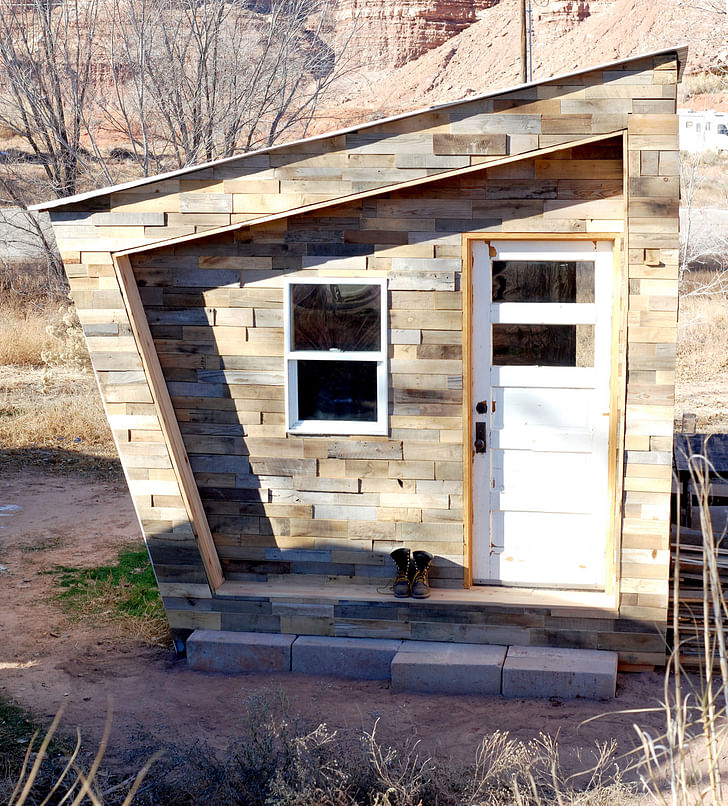
Nam Henderson:
In the late summer of 2013, I had a chance to visit Denver. There I made plans to meet with Lacy Williams and Patrick Beseda of the FOUNDhouse project (some of you may know them from their Archinect School Blog). Lacy and Patrick are currently students finishing up MArchs at University of Colorado - Denver. FOUNDhouse is the micro house (less than 150 ft2, or 14 m2) they designed and fabricated over the course of 2013. The project stems from a stated desire “to adopt a mobile, authentically sustainable way of living through the means of appropriate design and innovation”.
The project stems from a stated desire “to adopt a mobile, authentically sustainable way of living through the means of appropriate design and innovation”. Our interview took place at a local “sustainability park”, consisting mainly of a few vacant lots with some urban agriculture, a handful of architectural follies, Permaculture Pavilions, DIY architectures and vernacular greenhouse/garden sheds. When I arrive, they are on deadline to complete the fabrication. Fabrication and initial/beta installation need to be completed before all three (FOUNDhouse, Patrick and Lacy) relocate to a Native American reservation in the next few days, for a fall design/build semester. I arrive, chat, take some photos and help unload a trailer of parts and pallets.
During our time together, the three of us discussed their thoughts on using the Wikihouse system, digital fabrication, their own iterative design process, using Kickstarter as a funding model, the possibilities of DIY and the democratization of housing/shelter.

Interview with Patrick Beseda and Lacy Williams
Nam Henderson: So to start with, is this a thesis project? What is the genesis of the FOUNDhouse project?
Patrick Beseda: It all started when we got accepted to the Design Build Bluff semester, (a two semester sequence, where you design and build a house for a Navajo family on a reservation in Utah). When we went down to Bluff, we saw the living quarters were kind of tight. There are twenty-two students going, plus the director, plus two staff, plus our instructor. Really only beds for twenty. So Lacy and I thought we would bring our own. Originally we wanted to go down there during the summer and build something, but we found out we couldn’t get insured by the school. The University of Utah staff wouldn’t be there, so our instructor recommended that we prefab something in Denver and bring it down right before. We started design in, maybe, March. I had been hearing about the Wikihouse system. So we selected that as the structural system. Do you know anything about it?
NH: Yes, I’ve posted a few items regarding Wikihouse on Archinect. Are you using Wikihouse as the base but with modifications?
PB: We took the base construction system but adapted the form and size to our needs. Originally we had something - 150sq ft was our goal.
NH: Why those dimensions specifically? Personal comfort?
PB: We have been back and forth between trying to get it past code and past the building department. In Denver, the maximum structure you can have without a permit is 120sq ft and no higher than 8 feet off the ground. So we decided that doesn’t really lend itself to two people living together for four months. So we just picked a size that fit for us, and fit in the Wikihouse system. It knocks out the grid really nicely. And 150sq ft not only gives a good amount of functionality, but a lot of municipalities have 150sq ft as the maximum size. At that size it gets closer to a passable structure, that you can get a permit for.
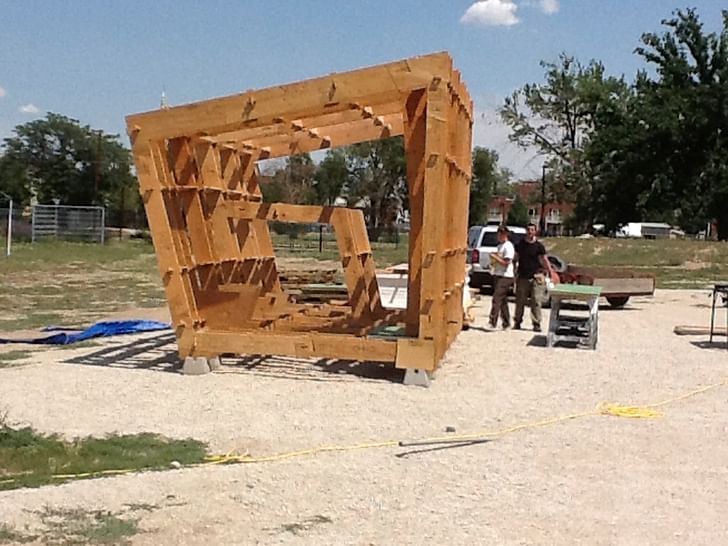

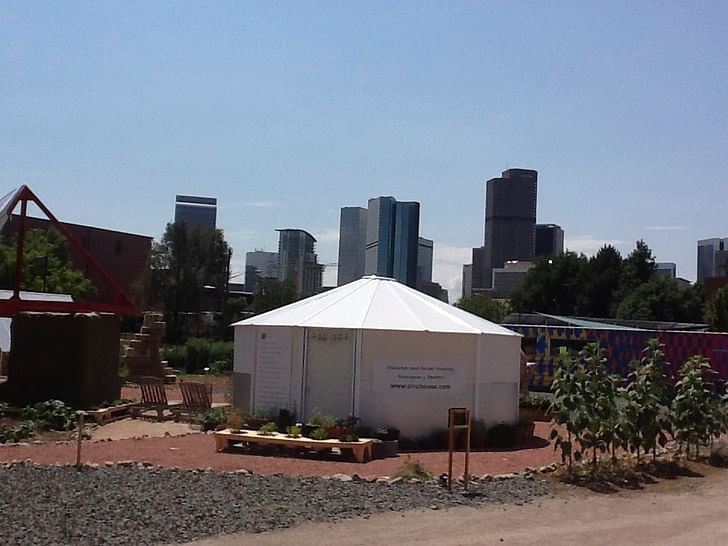
NH: Would that be the goal, to have this structure permitted?
PB: Not this [iteration], this is a prototype. It’s going to stay in Bluff: we are going to donate it to the non-profit, after the semester, as future student housing. I think Wikihouse as a goal, and for myself as a goal, having something like this pass code, pass inspection, would be huge in Denver at least.
NH: So is the plan for you two to develop the next iteration, within your studies?
PB: I think so. It is something we are both interested in. The digital fabrication and design, as well as the residential program, are socially important.
NH: Maybe as your thesis, or just as a side project?
PB: More like a side project. It doesn’t integrate with our studies yet. Though some mentors from school have helped. With the process and a few details.
NH: That’s a big commitment. Not much of a summer vacation.
PB: We both had internships lined up, we figured this was more fun, meaningful. A project from start to finish.
NH: So this isn’t even a part of what you will be doing at the reservation?
PB: That's right -- we’ve already gone through the design of the project for the Billjohns, our family. We designed them an 800sq ft home. A lot more traditional. SIP walls, roof, passive solar heating. We will be going down a few days early to set-up FOUNDhouse, it will be an ongoing project to completely finish the house in the first few weeks.
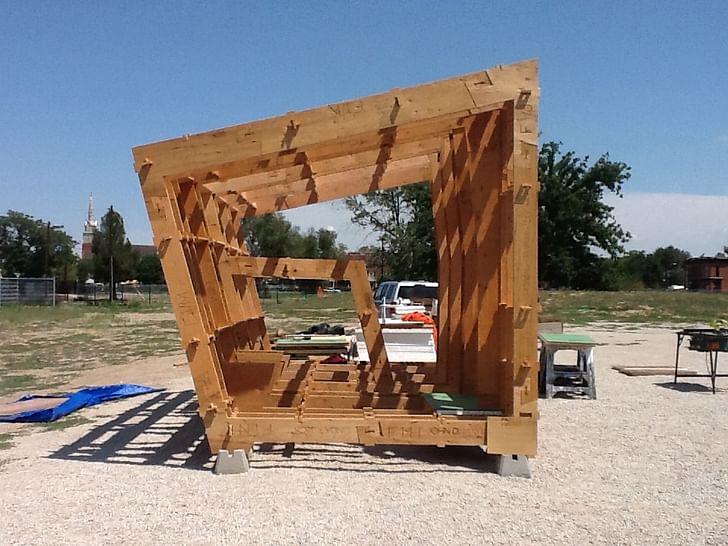

NH: You funded this via Kickstarter, which seems to be very common. A lot of students are doing it now. Did you pick that model for a reason? What was your experience? Were there any growing pains? Is it specifically useful for student projects? Is it a model perhaps for design-build outside of academia? Could you “practice” that way?
There is a big difference, you find out, between what you design digitally and what comes out.PB: We pitched it as a way to learn design/build, how to put a building together. But on the other-side, how to further this open-source project, Wikihouse. You can’t ask each backer "why did you support us?"; because you want to help us out, or because you believe in the open-source hardware? I feel like there was a lot more interest that we expected. The first person who backed us a 11$ was from New Zealand. There were people we didn’t know, which was awesome...humbling.
NH: If you are using Wikihouse as the foundation, does that mean all the modifications will be put back into the open-source world?
PB: We have been talking a lot with the Wikihouse group. They want to bring this into their design library. It will be our job after we finish building, to document and provide feedback to the Wikihouse team.
NH: So all the files, drawings, models...
PB: Yes. There is a lot of nomenclature, protocols that go with publishing something, for it to be universal. Part of the reason we decided to use the Wikihouse system was because there hasn’t been a fully inhabitable Wikihouse.

NH: They have all been pavilions, right. So by "fully inhabitable", you mean...?
PB: It’s about the function -- also insulation, power, water, thermal comfort. We are actually on the fence with some of those things. We will be leaning on some of the facilities down there. They have a bath-house. The plumbing is designed in but don’t think we are actually going to install it. We are a bit over budget. We have a solar kit. A kitchenette, so "fully inhabitable" means able to be lived in.
NH: So talking about some of those systems. We are in the West, which is obviously arid. How are you adapting to that? Will you be doing rainwater harvesting?
PB: Bluff is that high, dry climate. For us, we're really considering the insulative value of the walls. Double thickness EPS. Rainwater catchment. The small solar kit will provide a 12v DC system.
NH: What were some of the technical or code challenges you ran into?
PB: We haven’t run into anything with the building department. We have been sheltered by Red Line Gallery. We have installed it under the auspices of a temporary installation. And in Bluff, I don’t want to say there are no building codes… We are obviously designing it to be safe and habitable, but we don’t have to get it permitted, inspected.
NH: So it’s not going to fall down. What about learning the CNC technology?
PB: It is a really cool technology, but there is a big difference (you find out) between what you design digitally and what comes out. It is a whole other material process; a design problem to figure out. What are the tolerances that you need to actually connect the plywood? How does that translate into the way you run the machine, the bit size? How clean are the cuts? How does that then translate into what you draw? We worked both ways. We drew what we thought would work. Tested it and then went in reverse. That took us awhile. We have now stumbled into a good way.

NH: What has the reception been at your school, or in the larger design community here in Denver? Any involvement or awareness?
PB: At the school, definitely. We have talked to a couple of architects and developers. The reception there has been a bit odd. It is always about money a bit more than critical reception. Is it marketable, who wants this, who will buy it? To me, I think you have to beta test a product, to get it right.
NH: Let's talk about timeline. What is next?
PB: We start next week with [the Design Build] down in Bluff. Then we want to publish everything in January. Environmental data, qualitative observations. Is this feasible in an urban context, or is it site/job specific? Then see what the community reception is. What the people in Bluff, the design community, what Wikihouse thinks of it. My ideal dream would be then to come back to Denver, build a new one and then use it as an education or marketing model.
NH: Perhaps even as temporary housing? Have you all talked to any local non-profit organizations working on housing or shelter issues?
PB: We haven’t yet. I think Sustainability Park could really help in that way. They have these two blocks. They have only really developed the front half of one block. It would be interesting to approach them with something like that.

Interlude - At this point Lacy drives up, pulling a trailer with freshly milled parts. She also has a number of pallets in the trailer. Patrick explains that they plan on making FOUNDhouse's cladding from all recycled pallets.
NH: I was asking Patrick about the next logical step. Is this going to be an iterative thing for you both?
Lacy Williams: I see it continuing. The timeline I am not sure of, since we need to return to school and finish our last semester. But we already know so many things that we would do differently, or adjust in the process. All that experience is too valuable to not do anything with. I guess we haven’t talked about it. I would love to do another one.
PB: Every day we discover we missed that detail. We did this backwards. We should have done this first.
LW: Just providing a manual to Wikihouse, to have those little things we found, [is a next step]. The way we can adjust the files.
NH: I know a few architects and designers who have been talking about manuals, guidebooks. Is part of your interest that generative process?
PB: Because [the manuals] don’t exist, we are trying to author the processes to fabricate the thing. We offered up our working files as a Kickstarter rewards.
NH: What were some other rewards?
LW: We designed a laser-cut postcard/stamp, hybrid digital drawings with renderings, and used the building scraps to make a 3 or 5 piece flatpack sculpture.
* * *

Once relocated to Utah, Lacy and Patrick found it tough to work on their house during the week, but the weekend and the weeks off were very productive. To the bones I saw in Denver, they added a framed wall to each end to close it off, installed windows and doors, insulated with 2" rigid EPS, and even completed the exterior cladding of deconstructed pallets. For the most part, they lived self sufficiently, using the solar panel, a propane stove and storing all their stuff in the house. They did end up using the bathhouse for showers and toilets, and the refrigerator in the main living quarters.
However, the partners are clear that this is but the first iteration, a prototype micro-house. But to what end? Definitely, a critical act of design/build, which explores the possibilities of Wiki-culture and digital fabrication? Perhaps as a tool for the democratization of shelter? Either way, very much a reflection of our times.
I hope FOUNDhouse, both this first and future iterations, can serve as catalyst within the greater Denver community to explore the possibilities of micro-open-source architecture.Let’s not forget micro housing, micro-unit efficiencies and other forms of micro-architecture were all the rage in 2013. Under Mayor Bloomberg, the New York City Department of Housing Preservation and Development (HPD) launched adAPT NYC, a competition to design an apartment building of “micro-units” with 275 - 300 square feet of living space. The winning team’s ‘My Micro NY’ project will create 55 new micro-units, 40 percent of which will be affordable beyond the competitive market rents. It will also be the first multi-unit building in Manhattan developed using modular construction.
Also last year, Donghyun Kim, an architectural designer who graduated from Cornell University, won second place in the Residential category for RE-THINKING THE FUTURE's International Architectural Thesis Award. Kim's "Micro Housing" proposal was a response to New York City's changing demographics of shrinking households and a lack of ground-level residential housing space. Even more relevant to the discussion at hand, in early 2013, the Denver Architectural League held a Micro Housing Ideas Competition for the design of an eight-unit micro-housing complex.
Reflecting on the award-winning designs, Jury Chair George Hoover, FAIA, architect and professor emeritus of architecture at University of Colorado, Denver, wrote "these winning entries succeed in setting thoughtful parameters for a rich dialogue about new possibilities for the way we live, starting with a conversation in Denver that we hope will expand nationally and beyond”.
Like Mr. Hoover, I hope FOUNDhouse, in its first and future iterations, can serve as a catalyst within the greater Denver community to explore the possibilities of micro-open-source architecture. In the last decade, the Denver metropolitan region has become a national example in terms of transit-oriented and infill development. Perhaps, looking back in ten years, the metropolitan region will be a hotbed of micro-housing?
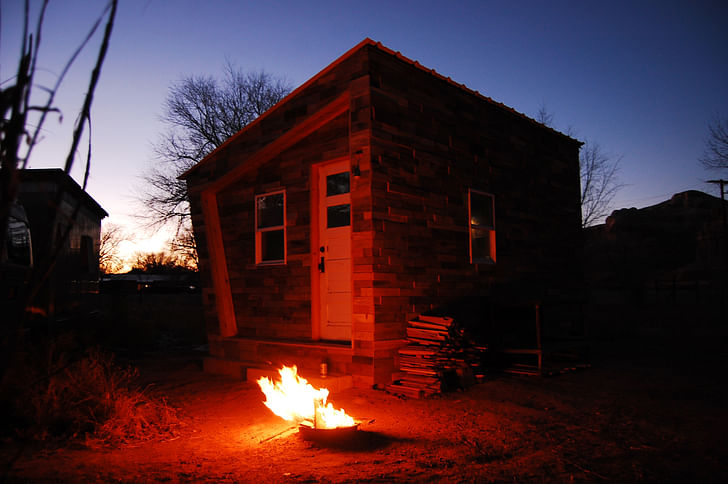
An ex-liberal arts student now in healthcare informatics, I am a friend of architects and lover of design. My interests include: learning/teaching, religion(s), sustainable ecologics/ies, technology and urban(isms). I was raised in NYC, but after almost two decades of living in North Florida I ...
4 Comments
Belíssimo trabalho, nos confirma a afirmativa de que a arquitetura é acessível e é para todos. Parabéns pelo post.
What does it smell like inside?
Cute house and nice interview. I love the confession, of sorts, that you have to use the system a little to understand how to work with it. Understanding the tolerance and possibilities of the materials and their joining systems is all I've ever wanted from good architecture (almost - poetry, too).
for a related/quick follow-up see re: a new micro-housing community called Quixote Village, for formerly homeless in Olympia Washington.
Block this user
Are you sure you want to block this user and hide all related comments throughout the site?
Archinect
This is your first comment on Archinect. Your comment will be visible once approved.